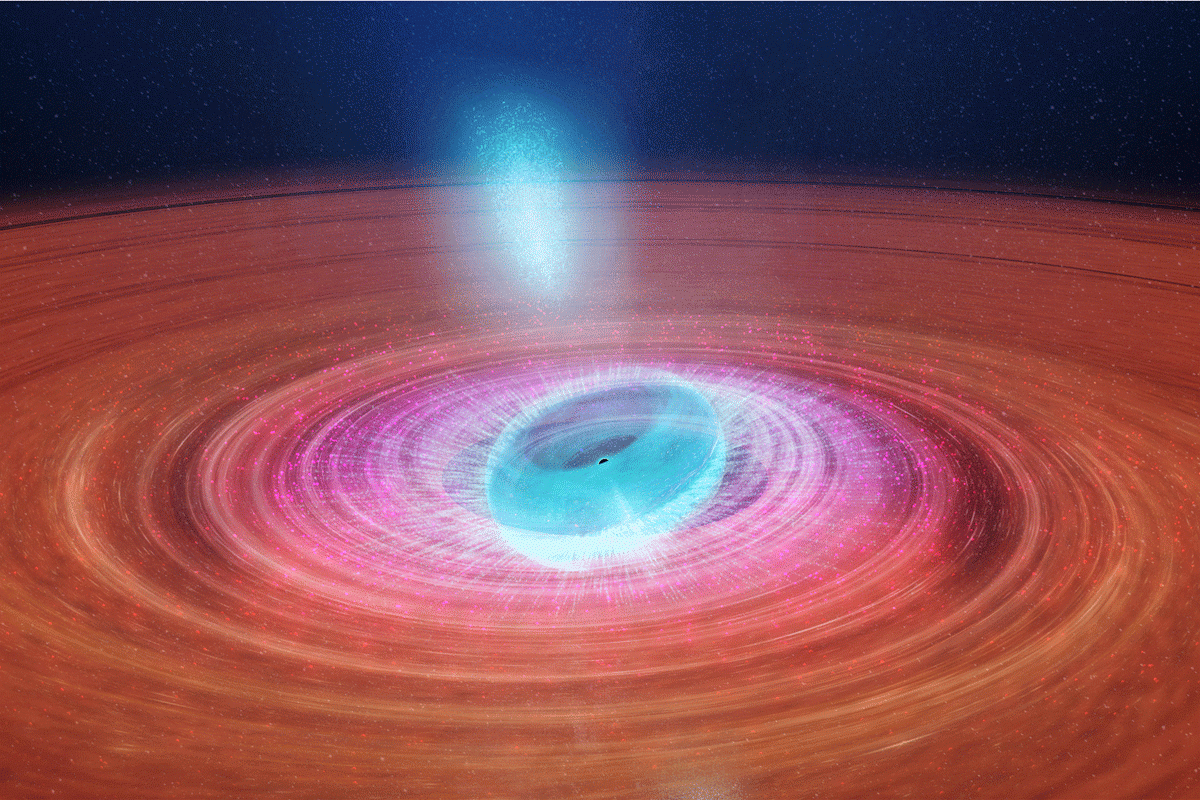Astronomers discover incredible swirling jets coming from black hole as it consumes star


An artist’s impression of jet ejections coming from stellar-mass black hole V404 Cygni. Photo: ICRAR
Australian astronomers have discovered a stellar-mass black hole “feeding” on a nearby star, resulting in the emission of powerful and dramatic spinning jets.
Mind-boggling research published in the scientific journal Nature on Tuesday shows jets from a black hole known as V404 Cygni behaving in a way never seen before on such short timescales.
The jets appear to be rapidly rotating with high-speed clouds of plasma — potentially just minutes apart —shooting out of the black hole in different directions.
V404 Cygni is nearly 8000 light years from Earth and about nine times the mass of our Sun.
The hole appears to be spinning at a different angle to the disk of material surrounding it, causing the inner part of the disk to wobble like a spinning top.

An artist’s impression of the black hole feeding on its companion star. Photo: ICRAR
This redirects the jets so that they move away at a range of different angles, spreading their energy over a wide area.
Black hole jets pump vast amounts of energy back into the surrounding universe, and this research shows us that these powerful beams of plasma can actually be redirected when a spinning black hole drags spacetime – the very fabric of our Universe – around with it.

An artist’s impression of twisted space-time around the spinning black hole. Photo: ICRAR
Lead author Associate Professor James Miller-Jones, from the Curtin University node of the International Centre for Radio Astronomy Research (ICRAR), said black holes are some of the most extreme objects in the Universe.
This is one of the most extraordinary black hole systems I’ve ever come across,” Associate Professor Miller-Jones said.
“Like many black holes, it’s feeding on a nearby star, pulling gas away from the star and forming a disk of material that encircles the black hole and spirals towards it under gravity.
“What’s different in V404 Cygni is that we think the disk of material and the black hole are misaligned.
“This appears to be causing the inner part of the disk to wobble like a spinning top and fire jets out in different directions as it changes orientation.”
‘Amazing observational coverage’
V404 Cygni was first identified as a black hole in 1989 when it released a big outburst of jets and radiation.
Astronomers looking at archival photographic plates then found previous outbursts in observations from 1938 and 1956.
Associate Professor Miller-Jones said that when V404 Cygni experienced another very bright outburst in 2015, lasting for two weeks, telescopes around the world tuned in to study what was going on.

An artist’s impression of the accretion disk around the black hole. Photo: ICRAR
“Everybody jumped on the outburst with whatever telescopes they could throw at it,” he said.
“So we have this amazing observational coverage.”
When Associate Professor Miller-Jones and his team studied the black hole, they saw its jets behaving in a way never seen before.
Where jets are usually thought to shoot straight out from the poles of black holes, these jets were shooting out in different directions at different times.
And they were changing direction very quickly – over no more than a couple of hours.
Associate Professor Miller-Jones said the change in the movement of the jets was because of the accretion disk – the rotating disk of matter around a black hole.
He said V404 Cygni’s accretion disk is 10 million kilometres wide, and the inner few thousand kilometres was puffed up and wobbling during the bright outburst.
“The inner part of the accretion disk was precessing and effectively pulling the jets around with it,” Associate Professor Miller-Jones said.
“You can think of it like the wobble of a spinning top as it slows down—only in this case, the wobble is caused by Einstein’s theory of general relativity.”
The research used observations from the Very Long Baseline Array, a continent-sized radio telescope made up of 10 dishes across the United States, from the Virgin Islands in the Caribbean to Hawaii.
Co-author Alex Tetarenko, an East Asian Observatory Fellow working in Hawaii, said the speed the jets were changing direction meant the scientists had to use a very different approach to most radio observations.
“Typically, radio telescopes produce a single image from several hours of observation,” she said.
“But these jets were changing so fast that in a four-hour image we just saw a blur.
“It was like trying to take a picture of a waterfall with a one-second shutter speed.”
Instead, the researchers produced 103 individual images, each about 70 seconds long, and joined them together into a movie.
“It was only by doing this that we were able to see these changes over a very short time period,” Dr Tetarenko said.








